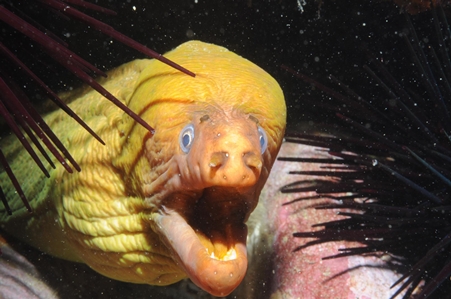Other Names
- Brown Reef Eel
- Green Eel
- Green Reef Eel
- Pettifogger
- Southern Green Moray
- Sydney Green Eel,
- Yellow Moray
General Description
Body long, slender, compressed; dorsal and anal fins continuous with the tail; pectoral fins absent; anterior nostril a tube on snout tip. Body greenish to brownish, head often yellowish. Outer surface of upper and lower jaws with an obvious row of pores, and large canine teeth. To 1.5 m.
Biology
Green morays are nocturnal, usually hiding in crevices, caves and under ledges during the day. Curious individuals have been known to bite divers.
Habitat
On rocky reefs in sheltered bays, estuaries and along the coast, in depths of 0-40 m.
Reefs
Distribution guide
New Zealand and southern Australia.
Species Group
Depth
Shore (0-1 m)
Shallow (1-30 m)
Water Column
Max Size
1.5 m
Commercial Species
No
Global Dispersal
Recorded in Australia
Conservation Status
- DSE Advisory List : Not listed
- EPBC Act 1999 : Not listed
- IUCN Red List : Not listed





